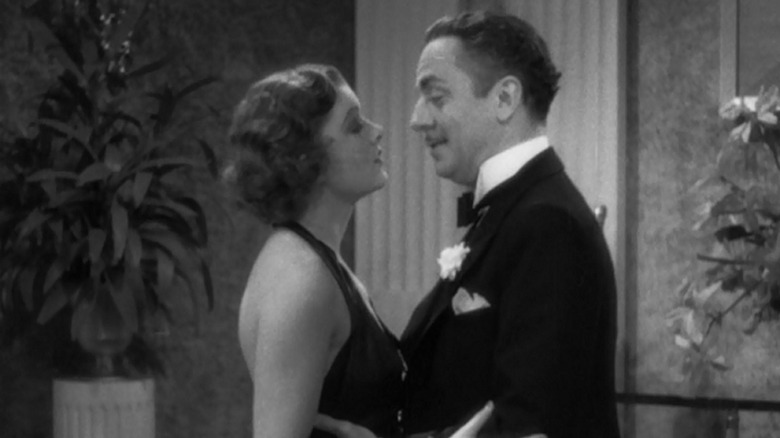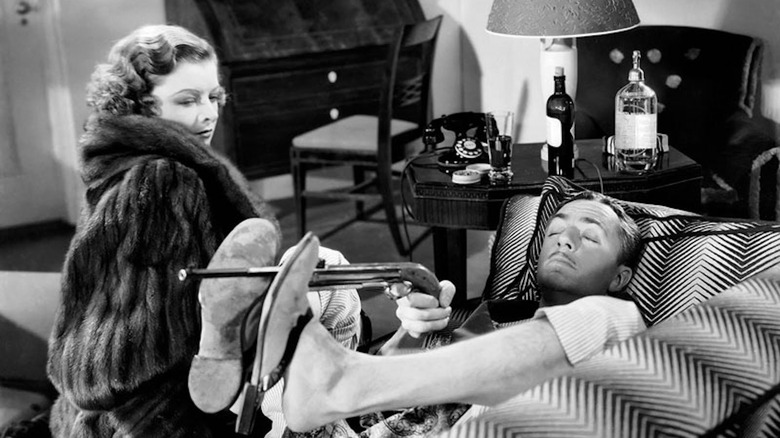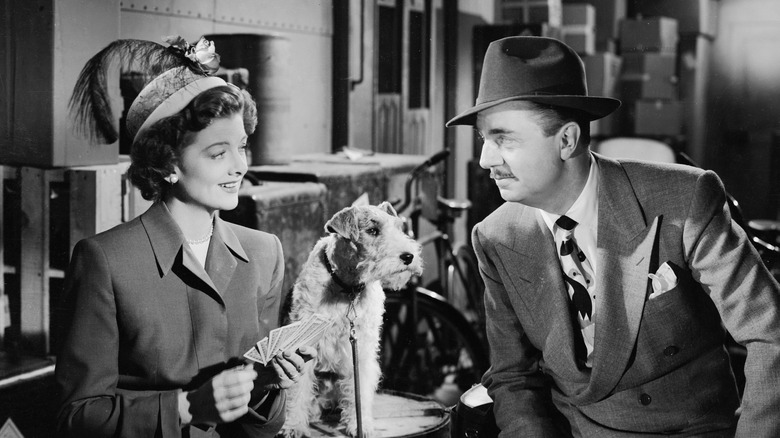The Correct Order To Watch The Thin Man Movies
Dashiell Hammett didn't invent detective fiction, he just perfected it — partially because he knew good and goddamn well of what he wrote. The high school dropout landed a gig with the Pinkerton National Detective Agency and evidently saw the worst side of the profession when his employer got fat off industrial cash by assigning their operatives to muscle, if not kill labor organizers. Years later, he laced his first published novel, "Red Harvest," with the bitter conscience of a man who witnessed evil but out of self-preservation did nothing.
Much of Hammett's work stings like a day drunk's swallow of rotgut whiskey, a belt they absorb over and over again to escape the awfulness of a world they cannot change in any meaningful way. The Continental Op eradicating a cluster of cold-blooded thugs with the 20-steps-ahead cool of a chess grandmaster in "Red Harvest" is so satisfying it's provided the foundation for several brilliant films (e.g. Akira Kurosawa's "Yojimbo," Sergio Leone's "A Fistful of Dollars" and Rian Johnson's "Brick"). But sooner or later you have to stumble out of the bar into a world that accepts and participates in the evil. And then there's the sledgehammer hangover.
So that, I believe, is why Hammett gave us Nick and Nora Charles.
The sleuthing duo of Hammett's "The Thin Man," the last novel he would ever finish (33 years before his death), are a joy. Nick's a former detective, Nora's a sharp-tongued socialite, and we fall fast in love with them as they solve a convoluted mystery in varying states of inebriation. Hammett's story was a sensation, and Hollywood quickly came calling. MGM won the rights and knocked out a lightning-in-a-bottle smash starring a perfectly matched William Powell and Myrna Loy.
Everything works in director W.S. Van Dyke's adaptation of "The Thin Man." MGM demanded more, and Hammett delivered. Stories, that is. He never wrote another novel. But the boozy hope of his last book was, like the hardboiled "Red Harvest," the basis for many enjoyable movies.
The correct viewing order
If you've clicked on this article, my guess is that you were utterly enthralled by Powell and Loy's fizzy repartee in the 1934 original and are now wondering if it's worth proceeding. I'm happy to report that it is, though you need to temper your expectations for the last couple of entries.
Let's get the order out of the way. Chronological is the way to go:
"The Thin Man" (1934)
"After the Thin Man" (1936)
"Another Thin Man" (1939)
"Shadow of the Thin Man" (1941)
"The Thin Man Goes Home" (1945)
"Song of the Thin Man" (1947)
The first film was shot in 14 days, but it never looks rushed. It certainly helped to have all-time-great cinematographer James Wong Howe behind the camera, but Van Dyke was apparently so confident in his leads and their ability to volley the whip-smart exchanges penned by the married screenwriting duo of Albert Hackett and Frances Goodrich that he shot and printed rehearsal takes. There were no complaints from Powell or Loy; indeed, the only diva on set was the dog cast as the Charles' terrier Asta (he once bit Loy).
When "The Thin Man" capped its sensational box-office run with four Oscar nominations (Picture, Director for Van Dyke, Actor for Powell, and Adapted Screenplay for Hackett/Goodrich), MGM could've easily pumped out sequels once a year, but Powell and Loy were suddenly in heavy demand. This wound up being a blessing. Three years in between movies allowed the actors to break off and lend their screwball comedy expertise to classics like "My Man Godfrey" and "Libeled Lady." When they reunited, it was an event; the stars, bolstered by Van Dyke's effortless direction and Hackett/Goodrich's dialogue, looked genuinely thrilled to be in each other's presence again.
A series that's still got its zip almost a century later
"After the Thin Man" (featuring an adorably wet-behind-the-ears James Stewart) and "Another Thin Man" are terrific in their own right. They're more refined, but the creative team knows you can't recapture the champagne-cork pop of the original. Just pour the drink, and let your audience catch a buzz.
Hackett and Goodrich's absence is notable in "Shadow of the Thin Man," but Van Dyke and his stars sell the heck out of the solid Harry Kurnitz-Irving Brecher. This was also the first installment without story input from Hammett, but the series was now well out of step with his fervent, highly contentious political convictions. That he found it in himself to write "The Thin Man" in the first place was gift enough.
If you want to save the least for last, maybe leapfrog to "Song of the Thin Man" and close out with "The Thin Man Goes Home." The latter is the first film to give us a fully sober Nick, and, well, that's the physically responsible play. The man's liver has been taking a beating for the last decade (and who knows how long before that), so nipping apple cider out of a flask is admirable self-care. It's also the most Nick-centric movie in the series, and Powell seems a tad peeved at shouldering the load.
"Song of the Thin Man" is a slight improvement. It's got more laughs. And it's got an 11-year-old Dean Stockwell as an amusingly precocious Nick Jr.
There have been attempts to recapture the affectionately quarrelsome magic of Powell and Loy over the years. I don't think anyone will get closer than Glenn Gordon Caron, who briefly struck neo-screwball crude with Bruce Willis and Cybill Shepherd on "Moonlighting." But this party will never rage like it did 90 years ago. So fix yourself a not-too-stiff one and lose yourself in the Charles' tippling reverie, where you can outwit the bad guys and feel absolutely spectacular doing it, damn the morning after.


